Polish forests
Poland is in the European lead, while concerning the area of all forests. They cover about 29,2 % of the country territory, and grow within the area of 9,1 million hectares. The overwhelming majority of the forests is state owned, of which almost 7,6 million hectares are managed by the State Forests National Forest Holding..
The number of Polish forest is still growing. The forestation rate of the country has increased from 21 % in 1945 to 29,2 % at the moment. Between 1995 and 2008, the forest area increased by 310 thousand ha. The basis for afforestation works is the "National Programme for Increasing the Forest Cover" (KPZL), assuming an increase of the forestation rate up to 30 % by 2020 and up to 33 % by 2050. Polish forests abound in flora, fauna and fungi. 65 % of the total number of animal species live there.
The forests grow in our country on poor soils, mainly because of the development of the agriculture in previous years. It influences the distribution of the types of the forest sites in Poland. Over 55 % of the forest areas is covered with coniferous forests. In other areas, there are forest sites, mainly the mixed ones. Their small part constitute alder and riparian forests – not more than 3 %.
In the years 1945 – 2011 the area of natural deciduous tree stands within the area of the State Forests National Forest Holding increased from 13 to 28,2 %.
Within the lowlands and uplands the most often occurring tee species is pine. It covers 64,3 % of the forest area of the State Forests National Forest Holding and 57,7 % of private and commune forests. In the mountains the predominant species is European spruce ( in the west) and European spruce with beech (in the east). Domination of pine is the result of carrying on sustainable forest management in the past. Once, the monocultures (crops or cultivations of one species) were the answer to the great demand of industry for wood. Such forests appeared to be quite fragile to climatic factors. They also were often the prey of pests' expansion.
In Polish forests, the share of other tree species, especially deciduous trees have been systematically increasing. The foresters have stepped aside from monocultures – that is why, they try to fit specific species of the forest stand to the natural stand, that would be proper for the given area. Thanks to that, in the years 1945 – 2011, the area of the deciduous tree stands within the lands of the State Forests National Forest Holding increased from 13 to 28,2 %. There occur more and more frequently the following tree species: oaks, ashes, maples, sycamore maples, elms, but also birches, beeches, alders, poplars, hornbeams, aspens, tilias and willows.
Our forests are the most often represented by the forest stands aged 40 to 80 years. The average age of the forest equals 60 years. More and more trees are of big size at the age over 80 years. Since the end of the Second World War, the forests' area has increased up to almost 1,85 million hectares.
Raport o stanie lasów w Polsce 2012
 Asset Publisher
Asset Publisher
 Asset Publisher
Asset Publisher
Użytkowanie lasu
Użytkowanie lasu
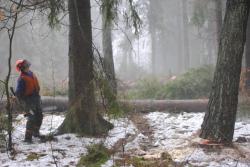 Ścinka drzewa (zdjęcie: Jerzy Wolski)
Ścinka drzewa (zdjęcie: Jerzy Wolski)
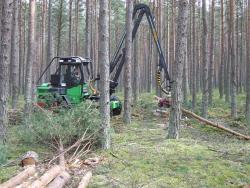 Pozyskanie drewna harwesterem (zdjęcie: M. Leszczyński)
Pozyskanie drewna harwesterem (zdjęcie: M. Leszczyński)
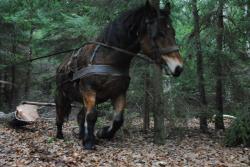 Zrywka konna drewna (zdjęcie: Jerzy Wolski)
Zrywka konna drewna (zdjęcie: Jerzy Wolski)
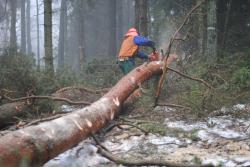 Okrzesywanie drzewa (zdjęcie: Jerzy Wolski)
Okrzesywanie drzewa (zdjęcie: Jerzy Wolski)
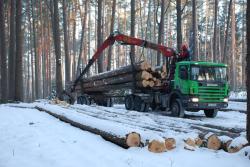 Załadunek drewna (zdjęcie: Dala Pieczulis-Leszczyńska)
Załadunek drewna (zdjęcie: Dala Pieczulis-Leszczyńska)
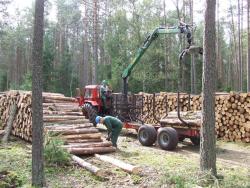 Zrywka drewna (zdjęcie: M. Leszczyński)
Zrywka drewna (zdjęcie: M. Leszczyński)
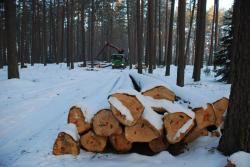 Drewno przygotowane do wywozu (zdjęcie: Dala Pieczulis-Leszczyńska)
Drewno przygotowane do wywozu (zdjęcie: Dala Pieczulis-Leszczyńska)
Użytkowanie lasu to korzystanie z jego zasobów – pozyskanie drewna, zbiór płodów runa leśnego, zbiór roślin lub ich części na potrzeby przemysłu farmaceutycznego, pozyskanie choinek, eksploatacja kopalin i wiele innych. Leśnicy umożliwiają społeczeństwu korzystanie z darów lasu, ale w sposób zapewniający mu trwałość.
Rozmiar pozyskania drewna określony jest w planie urządzenia lasu, który sporządzany jest dla każdego nadleśnictwa na 10 lat. Zapewnia on pozyskiwanie drewna w granicach nie tylko nieprzekraczających możliwości produkcyjnych lasu, lecz także systematycznie zwiększających zapas drewna pozostającego w lasach, tzw. zapas na pniu. Krótko mówiąc, leśnicy prowadzą w lasach gospodarkę w sposób zapewniający ich trwałość i możliwość biologicznego odtwarzania.
O wielkości pozyskania drewna decyduje tzw. etat cięć określony w każdym planie urządzenia lasu. Jest to ilość drewna możliwa do wycięcia w określonych drzewostanach na określonej powierzchni w okresie 10 lat, które obejmuje plan. Dzięki temu, że etat jest niższy niż przyrost drewna w tym samym okresie, następuje stały wzrost zapasu „drewna na pniu" (w Polsce pozyskuje się ok. 55 proc. przyrostu).
Pozyskane drewno pochodzi z:
- cięć rębnych – usuwania z lasu drzewostanów „dojrzałych"; ich podstawowym celem jest przebudowa i odtworzenie drzewostanów;
- cięć pielęgnacyjnych (czyszczeń i trzebieży) – usuwania z lasu części drzew uznanych za niepożądane i szkodliwe dla pozostałych drzew i wartościowych elementów drzewostanu;
- cięć niezaplanowanych – są one konsekwencją wystąpienia klęsk żywiołowych w lasach.
Nadleśnictwo Rytel prowadzi gospodarkę leśną na powierzchni ponad 17,5 tys. ha i pozyskuje rocznie ok. 70 tys. m sześc. drewna.
Drewno pozyskane na terenie Nadleśnictwa Rytel trafia głównie do przedsiębiorstw zajmujących się dalszym przerobem tego surowca: tartaków, zakładów przemysłu celulozowo-papierniczego, fabryk mebli oraz mniejszych zakłady stolarskich. Ponadto drewno opałowe kupowane jest przez nabywców indywidualnych na potrzeby gospodarstw domowych.
Zapoznaj się z ofertą sprzedaży drewna Nadleśnictwa Rytel.


 fot. Paweł Fabijański
fot. Paweł Fabijański
 fot. Paweł Fabijański
fot. Paweł Fabijański
 fot. Paweł Fabijański
fot. Paweł Fabijański





